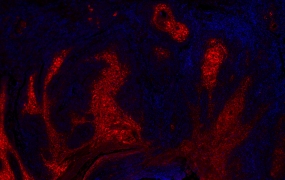How tumors suppress the development of metastases
Why do metastases often only appear after the original tumor has been surgically removed? Scientists from the German Cancer Research Center (Deutsches Krebsforschungszentrum, DKFZ) and the Mannheim Medical Faculty of Heidelberg University have now published an explanation for this phenomenon. They were able to identify a messenger substance of the cancer cells that locally promotes the growth of the primary tumor. In the blood, the messenger is split into two fragments, one of which suppresses metastasis. Tumor-bearing mice treated with the metastasis-inhibiting fragment survived cancer longer than untreated animals.

Squamous cell carcinoma of the skin expressing the messenger angiopoietin-like 4 (ANGPLT4).
© Augustin/DKFZ
Cancer doctors are familiar with the observation: in many of their patients, the usually life-threatening metastases only appear after the original tumor has been surgically removed. This phenomenon is particularly common in breast cancer and black skin cancer. Physicians have derived the concept of "concomitant tumor resistance" from this observation. It states that the original cancer focus, also called the primary tumor, can suppress the growth of the daughter tumors known as metastases.
The causes of this phenomenon are as yet poorly understood. Experts assume that the immune system plays a role, together with so-called angiogenic factors, which influence the connection of the metastases to the blood vessel system. From a size of about one millimeter, the daughter tumors depend on being supplied by blood vessels. Researchers were able to show several years ago that, depending on the tissue environment, tumors either release messenger substances that promote the formation of new blood vessels or factors that suppress the sprouting of new veins.
Scientists led by Hellmut Augustin and Moritz Felcht of the German Cancer Research Center and the Mannheim Medical School of Heidelberg University have now taken a closer look at the messenger angiopoietin-like 4 (ANGPLT4). "We became aware of ANGPLT4 because there are many contradictory publications on this factor," Augustin said. "While ANGPLT4 was initially described as promoting the formation of new blood vessels and thus also promoting cancer, other studies were able to prove the exact opposite and show that ANGPLT4 inhibits the development of metastases."
In comprehensive series of experiments on human and mouse tumors, the Heidelberg-Mannheim team elucidated a surprising mechanism. Among 38 different messenger substances that act on vascularization and possibly on concomitant tumor resistance, ANGPLT4 was found to be one of the molecules most strongly correlated with progressive tumor growth
ANGPLT4 is produced by cells of the primary tumor and locally promotes its growth. However, if the messenger substance is released into the bloodstream, it is cleaved. The two cleavage products are called nANGPLT4 and cANGPLT4. For reasons not yet fully understood, the n fragment (nANGPLT4) is found almost exclusively in serum. nANGPLT4, however, binds to a different receptor than either the intact molecule or the c fragment.
This receptor switch leads to the suppression of vessel growth and thus also the outgrowth of macrometastases. The researchers demonstrated this in numerous experimental approaches: Tumors transferred to mice formed fewer metastases after treatment with the n-fragment, and the animals survived longer.
"Of course, surgical removal of the primary tumors remains the gold standard in the treatment of most cancers," says Moritz Fecht. "But we now understand that this simultaneously dries up the source of the metastasis-suppressing n fragment. If nANGPLT4 is missing, individual dormant metastatic tumor cells can become active and grow into a dangerous macrometastasis," says Moritz Felcht. "By cleaving the protein in the body and the resulting opposite functions in tumor metastasis, we can now explain the contradictory results of previous studies."
"Many cancer patients could benefit from drugs that effectively suppress metastatic outgrowth. However, some of these agents have already failed in clinical trials. But in view of the enormous gain that such a drug could mean for those affected, it is worthwhile to continue researching ANGPLT4 preclinically and then clinically," Hellmut Augustin sums up.
Corinne Hübers, Ashik Ahmed Abdul Pari, Denise Grieshober, Martin Petkov, Alexander Schmidt, Tatjana Messmer, Christian Moritz Heyer, Sebastian Scholch, Stephanie Kapel, Nicolas Gengenbacher, Mahak Singhal, Benjamin Schieb, Claudine Fricke, Rainer Will, Kim Remans, Jochen Sven Utikal, Christoph Reissfelder, Matthias Schlesner, Kairbaan M. Hodivala-Dilke, Sander Kersten, Sergij Goerdt, Hellmut G. Augustin and Moritz Felcht: Primary tumor-derived systemic nANGPTL4 inhibits metastasis.
Journal of Experimental Medicine 2022, DOI: https://doi.org/10.1084/jem.20202595
With more than 3,000 employees, the German Cancer Research Center (Deutsches Krebsforschungszentrum, DKFZ) is Germany’s largest biomedical research institute. DKFZ scientists identify cancer risk factors, investigate how cancer progresses and develop new cancer prevention strategies. They are also developing new methods to diagnose tumors more precisely and treat cancer patients more successfully. The DKFZ's Cancer Information Service (KID) provides patients, interested citizens and experts with individual answers to questions relating to cancer.
To transfer promising approaches from cancer research to the clinic and thus improve the prognosis of cancer patients, the DKFZ cooperates with excellent research institutions and university hospitals throughout Germany:
The DKFZ is 90 percent financed by the Federal Ministry of Education and Research and 10 percent by the state of Baden-Württemberg. The DKFZ is a member of the Helmholtz Association of German Research Centers.

